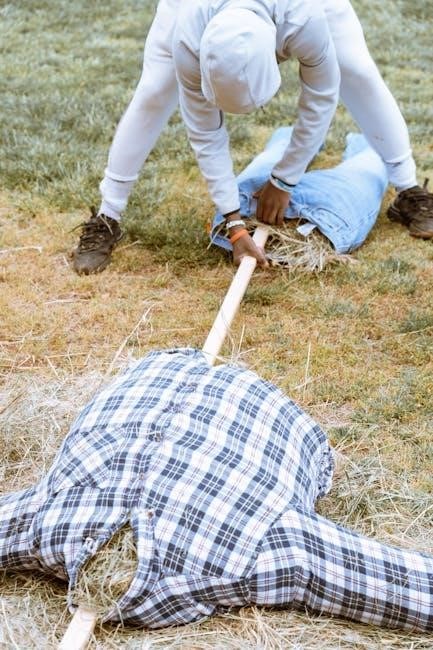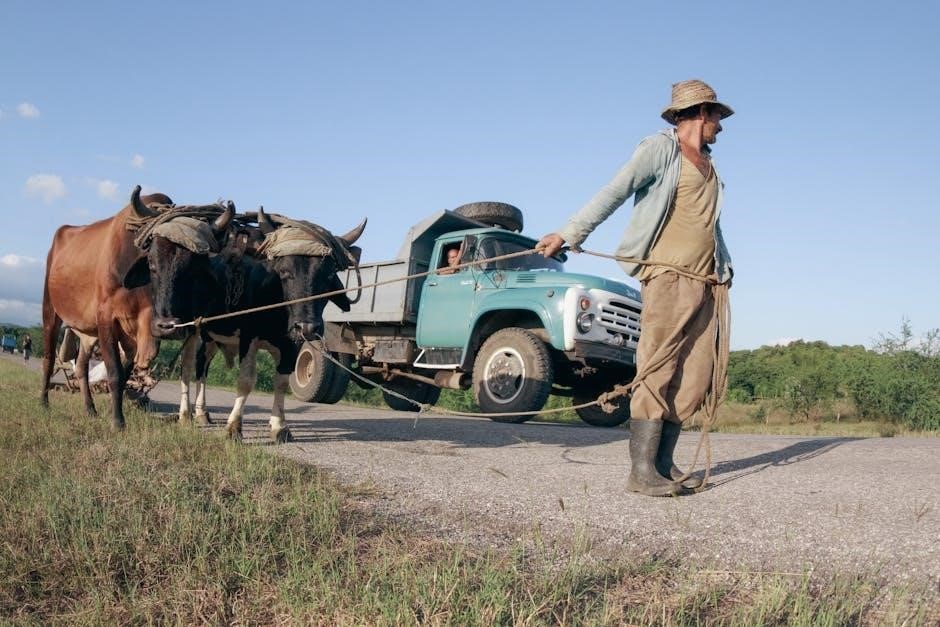Welcome to the NJROTC Cadet Field Manual, your essential guide to mastering military drill ceremonies, uniform regulations, and leadership development. This comprehensive resource provides detailed information to help cadets excel in their training and understand the core values of the program. Designed to be user-friendly, the manual ensures cadets have access to all necessary protocols, procedures, and guidelines in one organized document. Whether you’re a new recruit or an experienced cadet, this manual serves as your go-to reference for success in NJROTC.
1.1 Purpose of the Manual
The NJROTC Cadet Field Manual is designed to provide cadets with a comprehensive guide to military drill ceremonies, uniform regulations, and leadership development. Its primary purpose is to consolidate essential information into one accessible resource, ensuring cadets can meet rigorous standards. The manual covers proper drill procedures, uniform measurements, safety protocols, and leadership techniques. It serves as a quick reference for cadets to understand expectations, improve performance, and achieve excellence in their training. By following this manual, cadets can develop the skills and discipline necessary to succeed in the NJROTC program.
1.2 Structure and Content Overview
The NJROTC Cadet Field Manual is organized into 13 main sections, each addressing specific aspects of cadet training. Topics range from uniform regulations and drill ceremonies to leadership, safety, and physical fitness. The manual begins with an introduction and purpose statement, followed by detailed sections on uniforms, drill commands, and leadership development. Appendices provide additional resources, references, and a glossary of terms. This structured approach ensures cadets can easily navigate and access information, making it an indispensable tool for their growth and success in the NJROTC program.

Uniform Regulations
This section outlines the regulations and standards for NJROTC cadet uniforms, ensuring a professional and consistent appearance. It covers proper wear, measurements, grooming, and authorized accessories for all cadets.
2.1 Grooming Standards for Cadets
Proper grooming is essential for maintaining a professional military appearance. Male cadets must keep hair neat, with no extreme styles, and be clean-shaven. Female cadets should wear hair in a neat, pulled-back style. Nails must be trimmed and clean. Makeup and jewelry should be subdued. These standards ensure uniformity and discipline, reflecting the values of the NJROTC program. Adherence to grooming guidelines is mandatory for all cadets, regardless of rank or position, to uphold the unit’s image and maintain military decorum.
2.2 Uniform Measurements and Specifications
Uniform measurements and specifications ensure a professional appearance. The distance from the pocket to the name tag is standardized, with precise guidelines for placement. Shirts must fit snugly, sleeves aligned with the shoulder seam, and trousers creased sharply. Shoes are polished to a high gloss, with laces tucked neatly. Accessories like belts and buckles must meet size and style requirements. Fabrics and colors are specified to maintain uniformity. These detailed measurements ensure consistency and uphold the NJROTC’s image, promoting discipline and pride among cadets.
2.3 Uniform Regulations for Female Cadets
Female cadets must adhere to specific uniform regulations to maintain professionalism and uniformity. Hair must be styled neatly, avoiding bulky accessories, and kept above the collar. Makeup should be subtle and not distract from the uniform. Uniforms must fit properly, with skirts and trousers meeting length and style requirements. Shoes are polished to a high shine, and accessories like scarves and belts must conform to size and color standards. These guidelines ensure a cohesive and respectful appearance, aligning with NJROTC’s commitment to discipline and precision.
Military Drill Ceremonies
Military drill ceremonies emphasize precision, discipline, and teamwork. They include formations, marching, and rifle handling, fostering unit cohesion and pride. Proper execution reflects professionalism and respect for tradition.
3.1 Basic Drill Commands and Movements
Basic drill commands and movements are foundational to military precision and discipline. Commands such as “Attention,” “At Ease,” and “Present Arms” are executed with sharp, deliberate actions. Movements like “Right Face,” “Left Face,” and “About Face” require cadets to maintain alignment and coordination. Proper posture, heel-to-toe alignment, and synchronized steps ensure uniformity in formations. Mastery of these fundamentals builds confidence, promotes teamwork, and prepares cadets for more complex drills. Regular practice and repetition are essential for flawless execution, reflecting the professionalism and pride of the NJROTC program.
3.2 Formation and Alignment Techniques
Proper formation and alignment are critical for maintaining unit cohesion and military bearing. Cadets must understand how to establish and maintain intervals, dress lines, and alignment. The guide is the primary reference point, ensuring uniformity in spacing and positioning. Techniques include using the guide’s armpits for shoulder alignment and counting cadences to maintain consistent intervals. Regular practice in forming up and adjusting positions helps cadets master these skills, projecting discipline and unity during drills and ceremonies. Precision in formation and alignment reflects the overall professionalism of the unit.
3.4 Rifle Drill and Handling Procedures
Rifle drill and handling are essential skills for NJROTC cadets, emphasizing safety, precision, and military bearing. Cadets learn proper techniques for carrying, presenting, and maneuvering with drill rifles. Safety protocols are stressed to prevent accidents, ensuring cadets understand the importance of handling equipment responsibly. Drills include presenting arms, port arms, and order arms, with commands guiding each movement. Mastery of these procedures prepares cadets for ceremonies, competitions, and unit events, fostering discipline and teamwork. Continuous practice is crucial for perfecting rifle handling, reflecting the unit’s professionalism and adherence to military standards.

Leadership and Teamwork
Leadership and teamwork are vital components of the NJROTC program, fostering personal growth and unit cohesion. Cadets learn to inspire others, collaborate effectively, and achieve shared goals.
4.1 Developing Leadership Skills
Developing leadership skills is a cornerstone of the NJROTC program, empowering cadets to inspire and guide others effectively. Through structured training and hands-on experiences, cadets learn to communicate clearly, build confidence, and make ethical decisions. Leadership development emphasizes setting goals, problem-solving, and fostering teamwork. Cadets are encouraged to take on mentorship roles, fostering a culture of mutual support and accountability. These skills not only enhance personal growth but also prepare cadets for future leadership roles in both military and civilian settings, ensuring they become capable and compassionate leaders.
4.2 Importance of Teamwork in NJROTC
Teamwork is a vital component of NJROTC, emphasizing collaboration and unity among cadets to achieve common goals. By working together, cadets build trust, improve communication, and enhance problem-solving abilities. Shared responsibilities in drill ceremonies, competitions, and community service strengthen camaraderie and accountability. Teamwork fosters a supportive environment where cadets can rely on one another, ensuring collective success. This collaborative spirit not only benefits the unit but also prepares individuals for the teamwork required in future careers, both military and civilian, promoting a lifelong commitment to unity and cooperation.

Safety and Handling of Drill Equipment
Proper handling and storage of drill equipment are crucial to prevent accidents. Always inspect equipment, follow safety guidelines, and ensure adult supervision during practice. Safety first!
5.1 Proper Handling of Drill Rifles
Proper handling of drill rifles ensures safety and professionalism. Always grip the rifle firmly, keep your finger off the trigger, and maintain muzzle awareness. Inspect rifles before use for damage or defects. Store rifles securely in designated areas when not in use. Avoid horseplay or careless handling to prevent accidents. Cadets should practice correct posture and movement techniques to maintain control. Regularly clean and maintain rifles to preserve their condition. Follow instructor guidance and established protocols for handling drill equipment responsibly.
5.2 Safety Protocols During Drill Practice
Safety is paramount during drill practice. Always inspect equipment for damage before use and ensure proper handling techniques to prevent accidents. Maintain awareness of your surroundings and keep a safe distance from others. Never point a drill rifle at anyone or yourself. Follow instructors’ commands precisely and stay in designated practice areas. Secure rifles when not in use and avoid horseplay. Regular safety briefings and adherence to protocols ensure a risk-free environment. Report any unsafe conditions immediately to prevent incidents and uphold drill practice standards.

Military Customs and Courtesies
Military customs and courtesies uphold tradition, respect, and discipline. They include proper saluting, addressing superiors, and maintaining decorum in uniform, fostering unity and professionalism within the corps.
6.1 Saluting and Addressing Instructors
Saluting and addressing instructors are fundamental customs in NJROTC, demonstrating respect and discipline. Cadets must salute all uniformed personnel of higher rank and instructors upon greeting or parting. Proper saluting involves raising the right hand to the brow, keeping the elbow slightly forward, and maintaining eye contact. Addressing instructors by their rank or title, such as “Sir” or “Ma’am,” is mandatory. These actions foster a culture of professionalism and unity. Cadets should practice these protocols consistently to uphold unit pride and personal integrity.
6.2 Proper Etiquette in Uniform
Proper etiquette in uniform is crucial for maintaining a professional image. Cadets must wear their uniforms with pride, ensuring they are clean, well-fitted, and correctly aligned. Personal grooming standards should be strictly adhered to, avoiding excessive jewelry or unconventional hairstyles. When in uniform, cadets should refrain from casual behavior such as slouching or chewing gum. Public displays of affection are also discouraged. Maintaining composure and respect for the uniform reflects positively on the individual and the NJROTC program as a whole;

Land Navigation and Orienteering
Essential skills for cadets, land navigation and orienteering teach map reading, compass use, and navigation techniques. Practical training builds confidence in outdoor environments, ensuring accuracy and efficiency.
7.1 Basic Map Reading Skills
Mastering basic map reading is crucial for navigation. Cadets learn to interpret map symbols, legends, and scales to identify terrain features and landmarks. Understanding grid systems and how to plot coordinates ensures accurate navigation. Topographic maps reveal elevation changes, aiding in route planning. By practicing map orientation and distance measurement, cadets build skills to navigate confidently in various environments. This foundational knowledge is essential for land navigation and real-world applications in orienteering exercises.
7.2 Using a Compass for Navigation
Using a compass for navigation is a fundamental skill. Cadets learn to identify key parts of a compass, such as the needle, dial, and baseplate. Proper techniques include setting a direction, measuring bearings, and following azimuths. Understanding how to orient the map with the compass ensures accurate navigation. Landmarks and reference points are used to maintain direction. Practice with compass exercises helps cadets master navigation in both day and night conditions, enhancing their ability to navigate confidently in the field.

Physical Fitness Standards
Physical fitness is a cornerstone of NJROTC, emphasizing cardiovascular endurance, strength, and flexibility. Cadets must meet specific standards to ensure readiness for challenges and promote a healthy lifestyle.
8.1 Fitness Requirements for Cadets
NJROTC cadets must meet specific physical fitness standards to ensure readiness and overall health. Requirements include passing a series of assessments such as push-ups, sit-ups, and a 1-mile run. These tests evaluate endurance, strength, and cardiovascular health. Cadets are encouraged to maintain a consistent workout routine to improve performance. Proper nutrition, hydration, and rest are also emphasized to support physical development. Meeting these standards is crucial for participation in drills, competitions, and other program activities, fostering discipline and teamwork while promoting a healthy lifestyle.
8.2 Training Tips for Improvement
To enhance fitness, cadets should focus on consistent practice and gradual progression. Incorporate strength training, cardio exercises, and flexibility routines into daily workouts. Setting achievable goals and tracking progress helps maintain motivation. Proper nutrition and adequate rest are essential for muscle recovery and overall performance. Cadets can also benefit from team workouts, fostering camaraderie and accountability. Mental preparation, including visualization techniques, can improve focus during assessments. Staying hydrated and listening to the body’s needs prevents injuries. By following these tips, cadets can steadily improve their physical fitness and meet NJROTC requirements effectively;

NJROTC Competitions and Events
NJROTC competitions and events foster teamwork, discipline, and leadership. Cadets participate in drill meets, academic bowls, and physical fitness challenges, showcasing their skills and unit pride.
9.1 Overview of Drill Team Competitions
NJROTC drill team competitions are a cornerstone of the program, testing cadets’ military precision, teamwork, and discipline. These events include drill and ceremonies, rifle exhibitions, and physical fitness challenges. Cadets showcase their mastery of synchronized movements, uniform appearance, and adherence to military standards. Competitions foster unit pride and healthy rivalry among teams. They also provide opportunities for cadets to demonstrate leadership, coordination, and composure under pressure. Participation in these events is a key component of NJROTC training, helping cadets develop skills that extend beyond the drill field.
9.2 Preparation Strategies for Success
To excel in NJROTC competitions, cadets must adopt structured preparation strategies. Develop a detailed practice schedule, focusing on perfecting drill movements and synchronizing team actions. Encourage cadets to review instructional videos and manuals to refine techniques. Assign team leaders to oversee drills and ensure accountability. Regularly conduct practice sessions, emphasizing precision and uniformity. Incorporate mock competitions to simulate real scenarios and build confidence. Encourage cadets to visualize success and maintain a positive mindset. Continuous improvement through feedback and adaptation is key to achieving top performance in drill team events.

Cadet Field Manual Appendices
The appendices provide useful resources, quick-reference guides, and a glossary of terms. These sections help cadets locate information quickly and understand key terminology effectively.
10.1 Useful Resources and References
The appendices include a variety of resources to support cadets in their NJROTC journey. These resources encompass instructional guides, official websites, and reference materials. Cadets can find detailed information on uniform regulations, drill techniques, and leadership development. Additionally, the section provides links to essential documents and forms, ensuring easy access to necessary tools. The resources are designed to enhance learning, improve performance, and foster a deeper understanding of NJROTC traditions and protocols. They serve as a valuable supplement to the manual, offering practical advice and up-to-date information.
10.2 Glossary of Terms
The glossary provides definitions for key terms and phrases used throughout the manual. It serves as a quick reference for cadets to understand specific terminology related to military drill, uniform regulations, and leadership concepts. Organized alphabetically, the glossary includes terms like “Attention,” “Parade Rest,” and “Squad,” ensuring clarity and consistency. This section is essential for mastering the language of NJROTC and performing duties confidently. Regular updates keep the glossary current with evolving procedures and terminology, making it an indispensable tool for every cadet.
Thank you for completing the NJROTC Cadet Field Manual. This guide has provided essential knowledge to excel in drill, leadership, and uniform standards. Mastering its contents will empower your growth as a disciplined and capable cadet, preparing you for future challenges and successes in NJROTC and beyond.
11.1 Importance of the Manual for Cadets
The NJROTC Cadet Field Manual is a vital resource for cadets, providing clear guidance on military protocols, uniform standards, and leadership principles. It serves as a comprehensive tool for personal and professional growth, ensuring cadets understand their roles and responsibilities. By mastering the manual, cadets develop discipline, accountability, and teamwork skills, which are essential for success in NJROTC and beyond. This guide not only prepares cadets for drills and ceremonies but also instills the values of integrity and service, fostering a strong foundation for future endeavors.
11.2 Final Tips for Mastering the Manual
To master the NJROTC Cadet Field Manual, cadets should review its content regularly and practice drills consistently. Focus on understanding uniform regulations and military customs to ensure compliance. Use visual aids and diagrams to reinforce learning, and seek clarification from instructors when needed. Track your progress and apply the manual’s teachings during training exercises. Stay updated with the latest edition for any revisions. Remember, mastery requires patience, dedication, and continuous effort. By following these tips, cadets will excel in their roles and embody the values of the NJROTC program effectively.

References and Further Reading
For additional insights, refer to the Cadet Reference Manual (CRM) and official NJROTC publications. Visit the NJROTC website for updated resources and guides. The 11th Edition of the Cadet Field Manual is also available for detailed information. These materials complement the manual, ensuring a comprehensive understanding of the program. Cadets are encouraged to explore these resources to deepen their knowledge and skills. Your feedback and recommendations are valued to enhance future editions of the manual.
Future Editions and Updates
The NJROTC Cadet Field Manual is continuously updated to reflect evolving program requirements and feedback from cadets and instructors. Future editions will incorporate new training methodologies, updated uniform standards, and enhanced drill procedures. Cadets are encouraged to submit recommendations for improvements to ensure the manual remains relevant and effective. Stay informed about the latest updates through official NJROTC channels and publications. Your input is vital to shaping the future of this essential resource for cadet success.